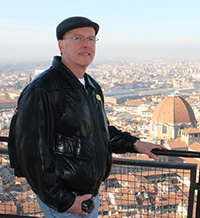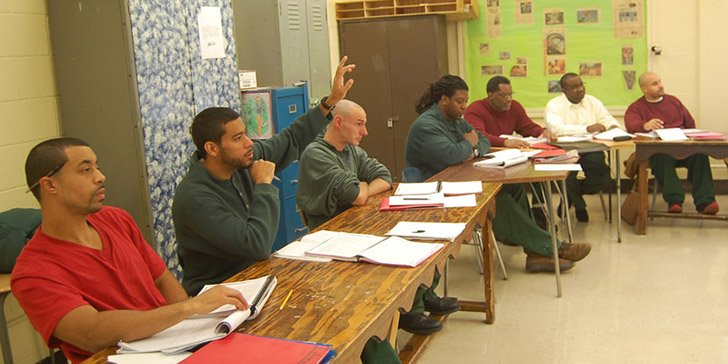Incarcerated Religion: Teaching behind Walls – Editor’s Introduction
Interest in understanding and working with and for the marginalized is a growing concern within the academy. The president-elect of the American Academy of Religion, Eddie Glaude, has declared that his focus during his presidential year will be on vulnerable populations. A yearly review of the AAR Annual Meeting program will find panels drawing from research with and teaching of various vulnerable populations. As all of the authors in this issue will attest, there is no group more vulnerable than those incarcerated in the various levels of our prison system: city, county, state, and federal.
On a personal note, some of my very first teaching experiences were as an adjunct in Mercer University’s prison program where I taught ethics and religion at a county jail, a state prison, a federal prison camp, and a federal penitentiary in the Atlanta area. No one could have prepared me for the experience and the challenges I would face, certainly not the traditional classrooms where I was educated. The settings were intimidating, especially once the bars behind me clanged shut. The classrooms were across the prison yard and isolated; they had limited resources. The educational backgrounds of the students were mixed. A few students had completed high school or some college and were seeking to continue their educations; most lacked good academic preparation. Some were from other countries, and they got caught up in illegal activities while seeking to find a better path for themselves and their families; English was their second language. Yet in spite of these shortcomings they were some of the most fascinating students I have ever taught. They brought significant life experience, insight, and diversity to the ethical and religious topics we explored. At first, I was what Robert Scott refers to as the professor who has intense experiences while teaching in prison (Scott 2012).
However, the traditional pedagogy with which I was familiar, lecture with some discussion, did not seem adequate for this setting, especially given the kinds of injustices experienced by many of my students prior to and after incarceration. For example, quite a number of my students in the federal penitentiary were there because they were victims of mandatory drug-sentencing laws: nineteen-year-olds who were convicted of “conspiracy” to sell drugs serving a minimum of sixteen years in prison, many of whom just happened to be at the wrong place at the wrong time. Meanwhile, across the way at the federal prison camp, white collar criminals convicted of income tax evasion or fraud, the effects of which had far greater repercussions for their victims, were living in dormitory style housing with organized softball leagues, serving sentences lasting one to two years. The disparities in the system and the power dynamics that created them were evident and these disparities became subject matter for the ethical and religious issues we addressed in class. In response, I began to explore more liberatory pedagogies which enabled us to bring these issues into clearer focus for understanding and discussion. These pedagogies continue to influence how and what I teach even in the traditional college setting. I relate these experiences because they were formative for me, something the authors in this issue of Spotlight also discuss in various ways.
The authors note the various challenges they face when teaching in prison. Liz Bounds relates her experiences of teaching in a Georgia women’s prison and the implications for her role as teacher. Where in most classrooms she is in the position of authority, in this setting the prison is the authority—restricting materials she can use and shortening class time unexpectedly because the inmate count is off. Yet this middle position is also a source of insight into the lives of her students and the complexity of prison life. Similarly, Andrew Skotnicki’s experience of teaching at Rikers Island illustrates how prison authorities can delay students from attending the class. More significantly, many of the students are detainees, which means that they might not be able to finish the class because their cases get adjudicated and they are released or sent on to a state penitentiary. The emotional, spiritual, and psychological toll this takes on the students adds to the challenge of educating them. James Wetzel wonders about the task of trusting the students he is about to teach, especially when the authorities and society at large suggest that the inmates are not worthy of that trust. Yet he is humbled by how he has become the recipient of the trust the inmates place in him as their teacher.
In spite of the challenges, the authors of these essays all note how rewarding the experience of teaching with and learning from this population is. Joshua Dubler speaks of the thrill he experiences teaching incarcerated students at a New York correctional facility because of the life experiences and perspectives they bring to the texts they study. They have not bought into the academic standards and mores of his on-campus students, and they are quick to point out when a text strikes them as preposterous or incomprehensible. Bounds notes the surprise and delight that many of the teachers find when they witness the intensity of desire to learn that the prisoners bring to the class. Melanie Webb discusses the joy and insight that many of the ministry students who are not incarcerated at Garden State Correctional Facility, but who participate in Princeton Theological Seminary's CTM-Inside Program, experience when they encounter the diversity of thought and personality represented among the incarcerated students. Skotnicki highlights the bonds of care and commitment forged between the privileged students from the main campus and the prisoners.
Finally, each of these essays in their own way seeks to raise consciousness about the structural and systemic problems of mass incarceration and the need to break down the walls that divide us. Wetzel notes that the problem of “mass incarceration” transcends the issue of crowded prisons and highlights the problems in our criminal justice system in particular and in American political culture more generally. Skotnicki incorporates the hermeneutical privilege of the poor as his class addresses the questions of the who, what, and why of our system of punishment. Dubler seeks to challenge the barriers we have erected between the incarcerated and the free in hopes of ending the dehumanization that makes incarcerated people invisible. Webb notes that in a society where mass incarceration is widespread, the imperative to come together to understand one another is crucial. Structuring the classroom and the pedagogy around mutuality and a common concern for ministry enables them to break down the walls that divide those imprisoned and those who are free. As a result, as one of the teachers in the Georgia women’s prison suggests, “education is freed from confinements of privilege and domination and unleashed.”
Resources
Scott, Robert. 2013. “Distinguishing Radical Teaching from Merely Having Intense Experiences While Teaching in Prison,” Radical Teacher 95 (Spring): 22–32.
 Fred Glennon is professor and chair of the Department of Religious Studies at Le Moyne College. He teaches a variety of courses in religious ethics, including Comparative Religious Ethics and Social Concerns (in classroom and online formats). His research and teaching focuses on religious ethics and social justice. He also writes and publishes in the area of the scholarship of teaching and learning, with a number of publications in Teaching Theology and Religion. He is coauthor of Introduction to the Study of Religion (Orbis Books, 2012), now in its second edition.
Fred Glennon is professor and chair of the Department of Religious Studies at Le Moyne College. He teaches a variety of courses in religious ethics, including Comparative Religious Ethics and Social Concerns (in classroom and online formats). His research and teaching focuses on religious ethics and social justice. He also writes and publishes in the area of the scholarship of teaching and learning, with a number of publications in Teaching Theology and Religion. He is coauthor of Introduction to the Study of Religion (Orbis Books, 2012), now in its second edition.
Photo: A student raises his hand in a English seminar facilitated by Cornell University at the Auburn Correctional Facility. Credit: Cornell Prison Education Program.

